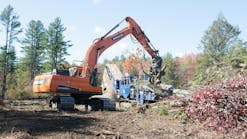Contractors now have a clear choice in motor graders. If you want a new M-Series motor grader from Caterpillar, you get a pair of joysticks replacing many levers and a steering wheel. But if you buy a new G-Series grader from John Deere, you can have a choice between console-mounted conventional controls or armrest-mounted, industry-standard fingertip controls. With the Deere machine, you’ll get the ever-present steering wheel. And if you choose Deere’s fingertip controls, you’ll have the choice between using lever steering or the steering wheel. The steering wheel is always active.
“With Deere’s G-Series, it’s not “˜one size fits all’-you’re free to choose the control style that makes you the most comfortable and productive,” says Kent Stickler, product marketing manager for motor graders, John Deere Construction and Forestry Co. “And every G-Series John Deere grader has a steering wheel, no matter whether you choose a G or a GP [Grade Pro].”
Caterpillar, on the other hand, says its new joystick controls-first introduced in 2006-have met with widespread customer acceptance. Caterpillar cites video clips on its Web site showing customers giving testimonials to the new controls. “The majority of people are comfortable within the first hour that they are on the (M-Series) machine,” says Wayne Wood, of Wayne Wood Grading in Arizona.
“It was pretty easy to get comfortable with [Cat’s M-Series] machine,” says Randy Gunther, Sheridan County, Montana. “Within 20 minutes I was doing what I was supposed to be doing.”
Caterpillar applied for more than 100 new patents while developing the new M-Series graders, and they include about 30% new content. New features include dynamic styling that opens up lines of sight, easy adjustment of the drawbar, circle, and moldboard (DCM), a high-torque all-wheel drive system, enhanced power management and emissions-compliant Caterpillar C-Series engines with ACERT exhaust emissions technology.
Caterpillar says the new control system opens up the interior of the cab and provides excellent lines of sight to the moldboard and snow-wing area. The cab doors are angled, and the floor is tapered to provide an unobstructed line of sight to the front tires, the heel and toe of the blade, and the DCM.
Top-accessible drawbar-wear inserts and patented moldboard slide-rail wear strips make DCM adjustments much faster and more convenient. Shorter service times reduce owning and operating costs.
Komatsu said it will introduce a new Dash 5 series of motor graders later this year-and the graders will have conventional controls and a steering wheel. “We’re lined up more with John Deere than with Caterpillar,” says Steve Moore, product manager of motor graders at Komatsu America.
Deere’s G-Series
Deere previewed its new G-Series of six motor graders at CONEXPO 2008, and now the new machines are available. With the new G-Series, Deere offers armrest controls on the seat to replace the old mechanical controls that required hydraulic valves underneath the cab. The absence of those valves and rods improves visibility to the ground and to the back of the blade. Deere will, however, continue to offer mechanical controls to those who want them-especially governmental customers.
The new GP controls allow Deere to integrate aftermarket global positioning systems (GPSs) either from Topcon or from Trimble. “This eliminates the need to put on a Topcon valve or a Trimble valve,” says Stickler. “Our system allows you to work with Trimble or Topcon equally well.”
And now, Deere has begun to offer a mid-mount scarifier. “Our old frame sloped down in front and didn’t allow us space for the mid-mount scarifier,” says Stickler. “The new frame rises higher toward the front of the machine.”
With the G-Series, Deere offers an automatic differential lock. The operator pushes a button and the diff lock comes on. Enter a curve, and it will go off automatically, then come back on automatically when you straighten out.
The G-Series includes three all-wheel drive models. If a model number ends in a “2” it is an all-wheel drive machine. The models are the 185-horsepower 670G; the 195-horsepower 672G; the 230-horsepower 770G; the 245-horsepower 772G; the 255-horsepower 870G; and the 275-horsepower 872G. A front push block and a rear-mounted ripper are available.
On all-wheel drive models, the front wheels are driven by hydrostatic motors, says Stickler. Two pumps in the rear of the grader send oil to the front motors. One pump is used for each front wheel. Sophisticated software controls the speed of the front wheels to match the rear-wheel speeds and speeds up the outside tire in a turn. The operator can make the front wheels more aggressive or less so depending on applications. “It engages all wheels at once very smoothly and adds productivity in all conditions,” says Stickler.
And with Deere’s Grade Pro model-the one with armrest fingertip controls-the operator can dial in the cross-slope that he wants to maintain. “He can set up a slave side of the blade and an automatic side,” says Stickler. “The operator runs the slave side and the other side of the blade lift is set automatically.”
All-Wheel Drive
Gary Atkinson, a Regional Product Manager with Volvo Road Machinery, explains that the company’s G900 family of graders is a “clean-sheet-design,” resulting from a special program of customer input. Previous Volvo models had Champion grader heritage. “The G900 family is all-Volvo,” says Atkinson. “The family consists of seven models-two all-wheel drive units and five tandem-drive machines. Engines range from 155 to 265 horsepower.”
Notable features on the G900 family include:
- a new front axle with tighter turning radius and reduced maintenance;
- a stiffer, stronger frame;
- a new cab with a high-output air-conditioning and heating system;
- a Tier 3-certified engine and redesigned cooling system;
- enhanced all-wheel-drive pulling power and user-friendly control.
“We moved to a much more technically advanced transmission,” says Atkinson. “Now we have two transmissions, the HTE 840, with eight forward and four reverse gears; and the HTE 1160, with 11 forward and six reverse gears. For the most precise fine-grading work, the 1160 features the lowest first gear in the industry. And top gear provides the fastest travel speed, at 31 miles per hour.” The transmissions use pulse-width modulation. “The goal is to provide smooth shifting from one gear to the other and better control over the shift points.”
Clutch packs typically use disks that lock up with hydraulic pressure, says Atkinson. But with modulation, the clutch packs engage gradually, so that you get a smoother shift. Shifting is electronically controlled. A vehicle Electronic Control Unit (ECU) communicates with the engine ECU to provide control over throttle functions and transmission-related functions. There is also a third computer, an instrument ECU. The combination of those three ECUs enables the operator to control grader functions and to provide for electronic diagnostics.
The three ECUs are tied into a system called Care Track. It’s a telematics system that interfaces with the Internet through GPS satellites and provides access to a wide variety of information, such as machine hours, transmission usage in each gear, time spent in different rpm ranges, and more. The system can flag improper clutch usage, express fuel consumption, flag low engine oil pressures, and diagnose a wide variety of problems.
Nationwide, contractors are finding that GPS pays for itself in improved grading productivity. Put simply, a GPS speeds up grading. No more stakes are needed. The accuracy is on the money, so you don’t waste material. Rework is a thing of the past; it’s done right the first time.So for McKee, the Trimble GPS has paid for itself on one project, where Thrift Development is widening a 5-mile stretch of Georgia Highway 17 from two to four lanes. Much of the project’s 700,000 cubic yards of embankment is required to build a new two-lane section with a 44-foot median between the new and existing roadways.The tight grade tolerances—plus or minus 1 quarter-inch—are required by the Georgia Department of Transportation on the top of the dirt subgrade and the top of the aggregate base course. “The Georgia DOT specs a tolerance of 1-half-inch total, and they will accept the GPS accuracy,” says McKee. “This is the first GPS project for this district of the DOT.”McKee has equipped one John Deere 672CH motor grader and two John Deere 750J dozers with Trimble GPS receivers. The motor grader and one of the dozers have automated blade-control systems. In automatic mode, the operator just steers the machine. The other dozer has a GPS with visual feedback only—the blade is manually controlled as the operator watches a light display.The GPS receivers have memory cards in them and are loaded with a digital model of the site. Thrift also uses a rover—a receiver mounted on a survey-like rod—to do some staking on the site. Thrift operators use the automated GPS grade control when they get within about 1 foot of finished grade, McKee says.
Not only does the GPS meet tight tolerances, but it also greatly improves production. “On rough grading it raises production by 30% to 40%, and on fine grading the improvement is 20% to 30%,” says McKee. “You reduce the amount of rework. Everything is put to finish grade the first time. You don’t have to go back and redress a slope.”
“This is an exceptional tool that allows for troubleshooting of machine or operator problems from a remote location,” says Atkinson. “In many cases, mechanics can pinpoint the problem and have the required tools and replacement parts with them, thus reducing the need for multiple trips to repair a failure. Care Track also provides time and geofencing to alert the equipment manager of unauthorized machine use or movement beyond customer-programmed time and geographical boundaries.
“The objective is to help the equipment manager to coach his operators,” says Atkinson. “For example, if an operator can run in a higher gear at lower engine speed, we can improve fuel efficiency. Volvo’s HTE1160 transmission allows for precise control of engine rpm’s at the operator’s desired ground speed to exactly match the application at hand.”
Komatsu’s New Lineup
Komatsu plans to continue to offer a dual mode transmission in its new Dash 5 line of three graders, which the company will introduce this year. The dual mode gives operators the choice of a direct-drive transmission locked up through a clutch, or a torque converter transmission. “The torque converter is more like the automatic transmission in a car,” says Moore. “You can just put your foot on the brake to stop the machine.”
For inching-type applications, such as cutting cul-de-sacs, the torque converter mode is preferable to the direct-drive mode.
Komatsu will increase engine horsepower ratings in its new Dash 5 models, Moore says. All three models will be variable horsepower machines; the GD655-5 will vary from 180 horsepower to 218 horsepower in higher gears.
Komatsu does not currently have an all-wheel-drive grader, but plans to offer one in 2010, Moore says.
The Dash 5 series will feature a transmission mounted in front of the engine for better weight distribution. “Now we’ll have a heavier grader with more weight on the front axle,” says Moore.
Cab comfort and visibility will be improved. “The newly designed cab will be more like the one on our new D51 dozer, which has been a big hit,” says Moore. And Dash 5 motor graders will be ready to “plug and play” with either Topcon or Trimble GPSs.
New From Case
Case Construction Equipment offers three new Tier 3-compliant graders. The 845DHP is a dual horsepower machine that runs at 140 horsepower in first through third gear, then shifts up to 160 horsepower from fourth gear upward. Case’s midsize model, the popular 865VHP, is a variable-horsepower machine. It starts at 180 horsepower in first, second, and third gears-shifts up to 190 horsepower in fourth through sixth-then runs at 205 horsepower in seventh and eighth gears. The largest Case grader, the 885, is powered by a 205-horsepower, 6.7-liter Cummins engine.
Higher horsepower in the higher gears means the grader can be more productive at higher speeds, says Mitch Blake, brand-marketing manager for Case Construction Equipment. “You couple that variable horsepower or dual horsepower with the involuted curvature of the blade on a Case grader, and you can really move some material quickly,” says Blake. “Snow plowing is where you really see a great advantage to the high horsepower in higher gears.
Blake says Case has a standard differential lock on all models except the smallest, the 845, which has a limited slip differential. “You typically use a smaller grader to cut cul-de-sacs and curves,” says Blake. “You don’t want to have an absolute diff lock in those situations. Case does not offer an all-wheel drive grader.
Blake points with pride to the serviceability of Case’s motor graders. “Everything is ground-level servicing,” he says. “You push one button and the whole rear engine hood comes up. It allows unparalleled access to engine components-belts, hoses, the works.”
Champion Adds to Its Lineup
Champion has introduced a pair of production machines-the 23,500-pound C110 and 24,000-pound C116-to fill the gap between its line of compact graders and full-size road-building machines. According to Bryan Abernathy, executive vice president for Champion Motor Graders of Charlotte, NC, “these new Champions are unique-they’re production-style machines in a smaller package.”
Powered by a Cummins QSB6.7 that meets Tier 3 emissions standards, and a fully sequential, direct-drive, eight-forward, four-reverse transmission, the C110 is capable of a top speed of 27 miles per hour.
As it does with its compact graders-five models ranging in size from 12,800 to 15,000 pounds-Champion offers a suite of options and attachments, including scarifiers, rippers, dozers, rollers, and tampers, along with pre-engineered brackets for automatic blade-control systems.



